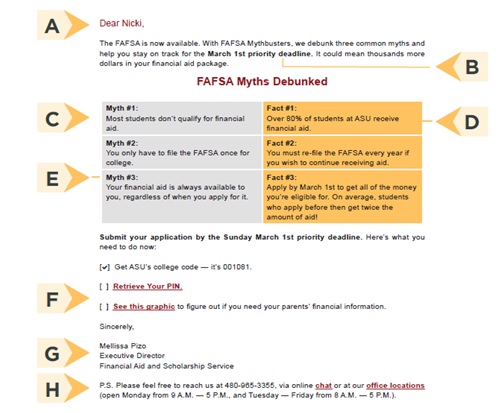
Beating the Deadline: Reminders to Apply for Financial Aid on Time
Organization : ideas42
Project Overview
Project Summary
Undergraduate students and their parents were sent a sequence of eight behaviorally informed reminder emails that encouraged them to submit financial aid applications ahead of the priority deadline.
Impact
Sending reminder emails to students and their parents increased the timely submission of applications by 21 percentage points, from 29% to 50%.
Cost
The intervention cost $0.15 per student, at scale.
Challenge
Many eligible college students fail to apply for financial aid offered by the federal government altogether. Of those who do apply, many more reduce their chances of receiving aid by failing to apply by the priority deadline. In the 2013-2014 school year, more than 80% of students at Arizona State University who filed their financial aid applications did so after the priority deadline had passed, which can result in a lower aid package. This project’s goal was to increase the number of continuing ASU undergraduate students applying for financial aid by the March 1 priority deadline.
Design
In the eight weeks leading up to the March 1 application deadline, ASU’s Financial Aid and Scholarship Service sent weekly reminder emails to selected continuing undergraduate students. Not only were the emails delivered more frequently than ASU’s standard practice of sending students a single email four weeks before the application deadline, they had also be redesigned. The new emails emphasized the priority filing deadline, encouraged students to talk with their parents about the financial information they would need, and included charts and graphs to make it easier to identify the application requirements. Redesigned emails also corrected the common misperception that most students don’t use financial aid, and encouraged students to approach the application process as a sequence of simple tasks instead of one complicated undertaking.

The first of eight redeigned emails
A. Personalized greeting may encourage readers to continue reading email
B. Increases salience of deadline through bolding and placement at top of email, making it more likely that students will notice it
C. Corrects common misperceptions about who qualifies for aid in friendly, easily understandable language
D. Shows widespread use of financial aid so that students feel it is acceptable and normal for them to apply for and receive aid
E. Makes clear the potential to lose full aid award, increasing motivation to file before deadline
F. Actionable guidance includes links to necessary information and next steps
G. Coming from a real person rather than an unidentified entity (e.g. the Financial Aid Office) makes email feel more personal, increasing engagement with contents
H. Postscripts are among the top things that people read in letters or emails, and here we included several outreach options to make it easier to access help
Impact
 A randomized evaluation found that among families where both students and parents received the redesigned emails, 50% filed their financial aid application by the priority deadline. In the group where only parents were sent the redesigned emails, 42% filed by the priority deadline, compared with 39% among the families in which only students were sent the redesigned emails. In each case, the redesigned emails represented an improvement over sending a single email: only 29% of the families who received it filed their financial aid application by the priority deadline.
A randomized evaluation found that among families where both students and parents received the redesigned emails, 50% filed their financial aid application by the priority deadline. In the group where only parents were sent the redesigned emails, 42% filed by the priority deadline, compared with 39% among the families in which only students were sent the redesigned emails. In each case, the redesigned emails represented an improvement over sending a single email: only 29% of the families who received it filed their financial aid application by the priority deadline.
In addition to filing earlier, students who were sent the redesigned emails received between $269 and $643 more in financial aid awards than students receiving ASU’s standard email. They were also more likely to have filed a FAFSA form by the end of the school year: 91% filed a FAFSA, compared to 88% of students who had not received redesigned emails.
Implementation Guidelines
Inspired to implement this design in your own work? Here are some things to think about before you get started:
- Are the behavioral drivers to the problem you are trying to solve similar to the ones described in the challenge section of this project?
- Is it feasible to adapt the design to address your problem?
- Could there be structural barriers at play that might keep the design from having the desired effect?
- Finally, we encourage you to make sure you monitor, test and take steps to iterate on designs often when either adapting them to a new context or scaling up to make sure they’re effective.


